Effect and Mechanism of Economic Circulation in the Middle and Lower Reaches of the Yellow River: Multiregional Input–Output Model and Industrial Complex Network Approaches
Abstract
1. Introduction
2. Methods and Models
2.1. MLYR–Multiregional Input–Output Model
2.2. Industrial Circular Network Model
- (a)
- Cycle length and relative frequency. The cycle length l is defined as the quantity of edges contained in a cycle and the cycle length relative frequency describes the relative quantity of industrial cycles to the present status of industrial cycles of each length [49]. The proportion of industrial cycles with cycle length equaling l in all the industrial cycles is defined as CF(l), as shown in Equation (7). The larger the proportion, the greater the circular influence of cycles of this length.where is the number of industrial cycles with cycle length of l in the ICN.
- (b)
- Average cycle correlation. The weight of an edge has an important influence on the efficiency of a network and is an important indicator in network analysis [50]. The average cycle correlation refers to the economic relevance of one edge in an industrial cycle, which describes the circulation ability of transmission and feedback of industrial cycles in economic circulation, as shown in Equation (8). The greater the value of , the more economic outputs induced by circular industrial chains of this length in the ICN.where is the weight of industrial cycle f, is the length of cycle f, denotes quantity of industrial cycles whose length is l, and is the total number of industrial cycles in the ICN.
- (c)
- Influence of the industrial cycle. Different edge weight distributions help to reveal internal structures and organization mechanisms of different networks [51]. We believe that relative weights of cycles can measure the internal circulation function and status of cycles in the ICN. The influence of the industrial cycle refers to relative weights of all the cycles and functional effects of cycles with different lengths in the ICN, as shown in Equation (9). The larger the value, the stronger the capacity of sustainable economic supply of circular industrial chains in the ICN.where represents the weight of the ICN, which is the sum of edge weights in the ICN.
- (d)
- Interactions of the weighted cycle. Relationships among nodes and the edge weight can be used to measure the structural balance of weighted networks [52]. We measure coordination among cycles by interactivity of weighted cycles. The interactions of the weighted cycle refer to the average number of relationships between a cycle and other cycles, which reflects the capability of interlocking other cycles with different lengths in the ICN, as shown in Equation (10). The larger the indicator, the stronger the capability of a circular industrial chain of this length in the ICN.where represents the number of connected edges between a cycle and other cycles.
- (e)
- Interregional product circular flows. In order to present the circulation mechanism, the interregional net product transfer matrix is applied [53].whereand represents a column vector of total outputs.
2.3. Data Source
3. Results and Discussions
3.1. Analysis of Circulation Effects in the MLYR
3.2. Analysis of Industrial Circular Mechanism
- (a)
- The high-order cycles () were composed of inter-provincial industrial chains, which had the strongest impact on interregional economic cooperation and product trade, but the number was greatly reduced. On the WI, interactions between the high-order cycles and the external cycles were strong, and were considerably higher in 2017 than those in 2012. With gradual extension of industrial circulation chains to the upstream and downstream industries, the coordination and integration of the high-order cycles in industrial economic circulation system were more effective, and economic feedback relationships were strengthened, which stimulated other circular cycles and supported economic sustainable growth. The numbers of industrial cycles of the MLYR in 2012 and 2017 were 9126 and 9902, respectively, while the proportion of the high-order cycles decreased from 44.69% to 27.39%. This was related to the decline in the SE and FE in Shandong and Shaanxi.
- (b)
- The low-order cycles () with weaker robustness and multiple feedbacks were generally distributed on intersections of industrial chains from neighboring provinces. In 2017, the AC of the low-order cycles dropped considerably compared to 2012, and the stability of inter-provincial industrial chains was reduced. Both AI and WI of the low-order cycles in the industrial circulation system were always at a low level, and the low-order cycles were insufficient in promoting the growth in output. According to the above results, circular activities between Shanxi and Inner Mongolia were relatively active, which was attributed to producing the low-order cycles as a result of the geographical adjacency of these two provinces.
- (c)
- The middle-order cycles () were mainly industrial cycles within a province, which meant that the industrial chains were relatively mature and stable. The number of middle-order cycles increased considerably, but it is difficult to promote industrial upgrading. In 2017, the CF of the middle-order cycles increased considerably, the influences in some regions of the MLYR were enhanced, and economic inner circulation was improved. From 2012 to 2017, the AC and AI of the middle-order cycles was maintained at a high level all of the time, which meant that stability and reorganization of industrial circular chains of medium length continued to be enhanced. This limited the interregional circulation effects of spillover and feedback in provinces such as Shandong and Shaanxi, decomposition of the middle-order cycles, and production of inter-provincial cycles.
3.3. Analysis of Regional and Industrial Circulation Flow
4. Conclusions and Suggestions
Author Contributions
Funding
Data Availability Statement
Conflicts of Interest
Appendix A. Name and Number of Industrial Sectors
| NO. | Industrial Sectors | Sectors after Merger | NO. | Industrial Sectors | Sectors after Merger | NO. | Industrial Sectors | Sectors after Merger |
| 1 | Agriculture, Forestry, Animal Husbandry and Fishery | Agriculture | 15 | Manufacture of metal products | Metal and non-metal | 29 | Wholesale and retail trades | Service |
| 2 | Mining and washing of coal | Mining and dressing | 16 | Manufacture of general-purpose machinery | Equipment manufacturing | 30 | Transport, storage, and postal services | |
| 3 | Extraction of petroleum and natural gas | 17 | Manufacture of special purpose machinery | 31 | Accommodation and catering | |||
| 4 | Mining and processing of metal ores | 18 | Manufacture of transport equipment | 32 | Information transfer, software and information technology services | |||
| 5 | Mining and processing of nonmetal and other ores | 19 | Manufacture of electrical machinery and equipment | 33 | Finance | |||
| 6 | Food and tobacco processing | Food and tobacco | 20 | Manufacture of communication equipment, computers and other electronic equipment | 34 | Real estate | ||
| 7 | Textile industry | Textile and clothing | 21 | Manufacture of measuring instruments | 35 | Leasing and commercial services | ||
| 8 | Manufacture of leather, fur, feather and related products | 22 | Other manufacturing | Other manufacturing | 36 | Scientific research and polytechnic services | ||
| 9 | Processing of timber and furniture | Wood processing | 23 | Comprehensive use of waste resources | 37 | Administration of water, environment, and public facilities | ||
| 10 | Manufacture of paper, printing and articles for culture, education and sport activity | Papermaking and printing | 24 | Repair of metal products, machinery and equipment | 38 | Resident, repair and other services | ||
| 11 | Processing of petroleum, coking, processing of nuclear fuel | Petrochemical | 25 | Production and distribution of electric power and heat power | Electrical and water supply | 39 | Education | |
| 12 | Manufacture of chemical products | 26 | Production and distribution of gas | 40 | Health care and social work | |||
| 13 | Manufacture of non-metallic mineral products | Metal and non-metal | 27 | Production and distribution of tap water | 41 | Culture, sports, and entertainment | ||
| 14 | Smelting and processing of metals | 28 | Construction | Construction | 42 | Public administration, social insurance, and social organizations |
References
- Bakare, O.; Okuonghae, N. Information Managers as Change Agents in achieving Sustainable Development in the 21st Century. J. Environ. Sci. Econ. 2022, 1, 58–66. [Google Scholar] [CrossRef]
- Maiwada, U.D.; Ahmad, A.J. Using Science, Technology, and Innovation (STI); in Achieving Sustainable Development in Developing Countries (DCS). J. Technol. Innov. Energy 2022, 1, 23–27. [Google Scholar] [CrossRef]
- Wang, L.H.; Zhao, X. Factor spatial flow, heterogeneous industrial agglomeration types and regional economic growth: An analysis based on the Yangtze River Delta and Northeast China. Study Explor. 2020, 1, 116–122. [Google Scholar]
- Zhao, X.Y.; Miao, X.T. On Development, Capital Investment and Regional Economic Growth-empirical Analysis Based on Data from Northeast China. J. Henan Norm. Univ. (Philos. Soc. Sci. Ed.) 2022, 49, 76–83. [Google Scholar]
- Zhu, J.Z.; Zhou, J.J. A study on the coordinated development of Beibu Gulf urban agglomeration with economic social environment coupling-taking Zhanjiang, Nanning and Haikouas examples. Mark. Wkly. 2022, 35, 39–43. [Google Scholar]
- Liu, Q.; Zhang, X.Q. Research on the Complex System of “Economy Society Environment” for High Quality Development of Green Economy in Shanghai in the New Era. Shanghai Qual. 2022, 8, 51–57. [Google Scholar]
- Ren, B.P.; Fu, Y.M.; Yang, Y.C. Measurement and improvement path of high-quality development level in Yellow River Basin. Stat. Inf. Forum 2022, 37, 89–99. [Google Scholar]
- National Bureau of Statistics. China Statistical Yearbook 2020; China Statistics Press: Beijing, China, 2021.
- Ning, Y.; Liu, Y.L.; Du, J.Q.; Yang, Y.Q.; Wang, Y.F. Sustainable development assessment of the Yellow River Basin and the coordinated development strategy. Acta Ecol. Sin. 2022, 42, 990–1001. [Google Scholar]
- Xu, G.Y.; Xue, D. Drive High-quality Development of the Yellow River Basin with High-level ecological Protection. Acad. J. Zhongzhou 2021, 10, 26–32. [Google Scholar]
- Li, J.; Liu, Y. China’s national economic circulation: A perspective of the structural and regional network relations. Econ. Res. J. 2022, 57, 27–42. [Google Scholar]
- Kolade, O.; Odumuyiwa, V.; Abolfathi, S.; Schröder, P.; Wakunuma, K.; Akanmu, I.; Whitehead, T.; Tijani, B.; Oyinlola, M. Technology acceptance and readiness of stakeholders for transitioning to a circular plastic economy in Africa. Technol. Forecast. Soc. Chang. 2022, 183, 121954. [Google Scholar] [CrossRef]
- Cheng, Y.; Wang, J.J.; Wang, Z.P.; Zhang, L.L.; Chen, W. Spatio-temporal evolution and innovation-driven development of China’s regional circular economy performance. ChinaPopul. Resour. Environ. 2022, 32, 115–125. [Google Scholar]
- Shang, Y.P.; Song, M.L.; Zhao, X. The development of China’s Circular Economy: From the perspective of environmental regulation. Waste Manag. 2022, 149, 186–198. [Google Scholar] [CrossRef]
- Gao, C.K.; Gao, C.B.; Song, K.H.; Fang, K.J. Pathways towards regional circular economy evaluated using material flow analysis and system dynamics. Resour. Conserv. Recycl. 2020, 154, 104527. [Google Scholar] [CrossRef]
- Franco, M.A. A system dynamics approach to product design and business model strategies for the circular economy. J. Clean. Prod. 2019, 241, 118327. [Google Scholar] [CrossRef]
- Škrinjarić, T. Empirical assessment of the circular economy of selected European countries. J. Clean. Prod. 2020, 255, 120246. [Google Scholar] [CrossRef]
- Kang, D.W.; Zheng, Y.J.; Qin, Y. Study on the Coordinated Development Level and Influencing Factors of Dual Circulation Economy. J. Tech. Econ. Manag. 2022, 8, 97–102. [Google Scholar]
- Gao, A.G.; Gong, X. Research on the Measurement and Influencing Factors of China’s Digital Economy Dual Circulation Preference. J. Wuling 2022, 47, 35–43. [Google Scholar]
- Sonis, M.; Hewings, G.J.D.; Gazel, R. The structure of multi-regional trade flows: Hierarchy, feedbacks and spatial linkages. Ann. Reg. Sci. 1995, 29, 409–430. [Google Scholar] [CrossRef]
- Sun, L.Y.; Luo, Y.F. The spatial spillover effect of economic growth in Sichuan and Chongqing region: Based on inter-regional input-output tables. J. Chongqing Univ. Technol. (Soc. Sci.) 2021, 8, 37–48. [Google Scholar]
- Wang, T.; Xiao, S.; Yan, J.; Zhang, P. Regional and sectoral structures of the Chinese economy: A network perspective from multi-regional input–output tables. Phys. A Stat. Mech. Its Appl. 2021, 581, 126196. [Google Scholar] [CrossRef]
- Li, Y.; Luo, E.; Zhang, H.; Tian, X.; Liu, T. Measuring interregional spillover and feedback effects of economy and CO2 emissions: A case study of the capital city agglomeration in China. Resour. Conserv. Recycl. 2018, 139, 104–113. [Google Scholar] [CrossRef]
- Malik, A.; Lafortune, G.; Carter, S.; Li, M.; Lenzen, M.; Kroll, C. International spillover effects in the EU’s textile supply chains: A global SDG assessment. J. Environ. Manag. 2021, 295, 113037. [Google Scholar] [CrossRef] [PubMed]
- Miller, R.E.; Blair, P.D. Input-Output Analysis: Foundations and Extensions; Cambridge University Press: Cambridge, UK, 1985. [Google Scholar]
- Round, J.I. Decomposing Multipliers for Economic Systems Involving Regional and World Trade. Econ. J. 1985, 378, 383–399. [Google Scholar] [CrossRef]
- Dietzenbacher, E. Interregional Multipliers: Look backward, looking forward. Reg. Stud. 2002, 2, 125–136. [Google Scholar] [CrossRef]
- Wang, L.F.; Xie, R.; Yang, L.G.; Chen, X.J.; Xie, H.X. Two-way Spillover Effects of Economic Growth between China and Countries along the “Belt and Road”. China Soft Sci. 2020, 12, 153–167. [Google Scholar]
- Kim, D.H.; Seung, C.K.; Seo, Y.I. Multi-regional economic impacts of recreational fisheries: Analysis of Small Sea Ranch in Gyeong-Nam Province, Korea. Mar. Policy 2017, 84, 90–98. [Google Scholar] [CrossRef]
- Sun, L.Y.; Luo, Y.F. Research on the spillover effects of the three growth poles on the Chengdu-Chongqing economic circle. Resour. Dev. Mark. 2022, 1–11. Available online: http://kns.cnki.net/kcms/detail/51.1448.n.20220808.0943.005.html (accessed on 24 September 2022).
- Kim, Y.J.; Lee, S.G.; Trimi, S. Industrial linkage and spillover effects of the logistics service industry: An input–output analysis. Serv. Bus. 2021, 15, 231–252. [Google Scholar] [CrossRef]
- Erkok, B. Current Account Deficit and Automotive Sector Nexus in Turkey: An Input-Output Analysis. Sosyoekonomi 2021, 29, 113–129. [Google Scholar] [CrossRef]
- Kim, K.H.; Kim, J.H.; Yoo, S.H. An Input-Output Analysis of the Economic Role and Effects of the Mining Industry in South Korea. Minerals 2020, 10, 624. [Google Scholar] [CrossRef]
- Norbu, N.P.; Tateno, Y.; Bolesta, A. Structural transformation and production linkages in Asia-Pacific least developed countries: An input-output analysis. Struct. Chang. Econ. Dyn. 2021, 59, 510–524. [Google Scholar] [CrossRef]
- Stamopoulos, D.; Dimas, P.; Tsakanikas, A. Exploring the structural effects of the ICT sector in the Greek economy: A quantitative approach based on input-output and network analysis. Telecommun. Policy 2022, 46, 102332. [Google Scholar] [CrossRef]
- Leontief, W. The economy as a circular flow. Struct. Chang. Econ. Dyn. 1991, 2, 181–212. [Google Scholar] [CrossRef]
- Tang, M.; Hong, J.; Liu, G.; Shen, G.Q. Exploring energy flows embodied in China’s economy from the regional and sectoral perspectives via combination of multi-regional input–output analysis and a complex network approach. Energy 2019, 170, 1191–1201. [Google Scholar] [CrossRef]
- Xun, Y.; Shi, W.S.; Liu, T. Research on the Structural Characteristics of Entertainment Industrial Correlation in China: Based on Dual Perspective of Input-Output and Network Analysis. Complexity 2021, 2021, 6426123. [Google Scholar] [CrossRef]
- Xiang, X.M. Research on inter-city economic linkage structure within a province: Based on the correction of Kij in the gravity model. Technol. Econ. 2020, 39, 128–137. [Google Scholar]
- Sharifkhani, A.; Simutin, M. Feedback loops in industry trade networks and the term structure of momentum profits. J. Financ. Econ. 2021, 141, 1171–1187. [Google Scholar] [CrossRef]
- Chen, G.Q.; Xiao, W.W. Research on the industrial association of financial industry in Shandong Province from the perspective of industrial network. Rev. Econ. Res. 2013, 47, 77–82. [Google Scholar]
- Yin, C. Modeling Industry Technology Flow Network and its Structural Effects. Sci. Technol. Prog. Policy 2017, 34, 62–70. [Google Scholar]
- Yin, C.; Ding, Q.Y.; Yang, Z.Y.; Cui, Y.X. Industrial Technology Diffusion Mechanism and Innovation Synergy Effect of Central Plains Urban agglomeration. Sci. Technol. Manag. Res. 2021, 41, 35–43. [Google Scholar]
- Yin, C. Introduction to Industrial Network Analysis; Social Science Literature Press: Beijing, China, 2018. [Google Scholar]
- Giscard, P.L.; Wilson, R.C. A centrality measure for cycles and subgraphs ii. Appl. Netw. Sci. 2018, 3, 9. [Google Scholar] [CrossRef] [PubMed]
- Huang, R.L.; Zhang, X. A Comparative Study of Industrial Multiplier, Spillover and Feedback Effect in the Yangtze River Delta Region-based on Multi-Region Input-output Model. Financ. Econ. Xinjiang 2020, 3, 17–28. [Google Scholar]
- Pan, W.Q. Regional economic development in China: An analysis based on spatial spillover effect. J. World Econ. 2015, 38, 120–142. [Google Scholar]
- Ye, Z.Y.; Jiang, Q.W. Industrial Linkage and Spatial Spillover Effects under Regional Integration of Yangtze River Delta. J. Nanjing Univ. Financ. Econ. 2020, 4, 34–44. [Google Scholar]
- Chen, X.Z. Comparative analysis of industrial cycle structure in Shandong Province. Dongyue Trib. 2015, 36, 98–102. [Google Scholar]
- Tian, L.; Di, Z.R.; Yao, H. Effect of distribution of weight on the efficiency of weighted networks. Acta Physica Sin. 2011, 60, 803–808. [Google Scholar] [CrossRef]
- Goswami, S.; Das, A.K.; Nandy, S.C. Sparsity of weighted networks: Measures and applications. Inf. Sci. 2021, 577, 557–578. [Google Scholar] [CrossRef]
- Yang, M.; Ma, L.; Wang, X.; Huang, M.; He, Q. An improved network structural balance approach based on weighted node-to-node influence with evolutionary algorithm. Appl. Soft Comput. 2020, 94, 106323. [Google Scholar] [CrossRef]
- Tan, Q.L.; Han, J.; Liu, Y. Correlation analysis and risk transfer of provincial virtual water flow based on input-output model. China Soft Sci. 2021, 6, 144–152. [Google Scholar]
- Zheng, H.; Bai, Y.; Wei, W.; Meng, J.; Zhang, Z.; Song, M.; Guan, D. Chinese provincial multi-regional input-output database for 2012 and 2017. Sci. Data 2021, 8, 244. [Google Scholar] [CrossRef] [PubMed]
- Wang, Y. The multiplier effect, spillover effects and feedback effects of the economic relationship between China and Japan. J. Int. Trade 2016, 4, 83–94. [Google Scholar]
- Jamil, M.N.; Rasheed, A.; Mukhtar, Z. Corporate Social Responsibility impacts sustainable organizational growth (firm performance): An empirical analysis of Pakistan stock exchange-listed firms. J. Environ. Sci. Econ. 2022, 1, 25–29. [Google Scholar] [CrossRef]
- Cristobal-Cipriano, C.M.; Arroyo, J.; Romualdo, A. Corporate Social Responsibility (CSR) Programs in Sarangani Province: Promotion of the Triple Bottom Line Framework of Sustainability. J. Environ. Sci. Econ. 2022, 1, 67–77. [Google Scholar] [CrossRef]
- Su, Y.; Li, Z.; Yang, C. Spatial Interaction Spillover Effects between Digital Financial Technology and Urban Ecological Efficiency in China: An Empirical Study Based on Spatial Simultaneous Equations. Int. J. Environ. Res. Public Health 2021, 18, 8535. [Google Scholar] [CrossRef] [PubMed]
- Jamil, M.N. Critical Analysis of Energy Consumption and Its Impact on Countries Economic Growth: An empirical analysis base on Countries income level. J. Environ. Sci. Econ. 2022, 1, 1–12. [Google Scholar] [CrossRef]
- Adebanjo, S.A.; Shakiru, T.H. Dynamic relationship between Air pollution and Economic growth in Jordan: An Empirical Analysis. J. Environ. Sci. Econ. 2022, 1, 30–43. [Google Scholar] [CrossRef]
- Jia, S.; Yang, C.; Wang, M.; Failler, P. Heterogeneous Impact of Land-Use on Climate Change: Study from a Spatial Perspective. Front. Environ. Sci. 2022, 10, 840603. [Google Scholar] [CrossRef]
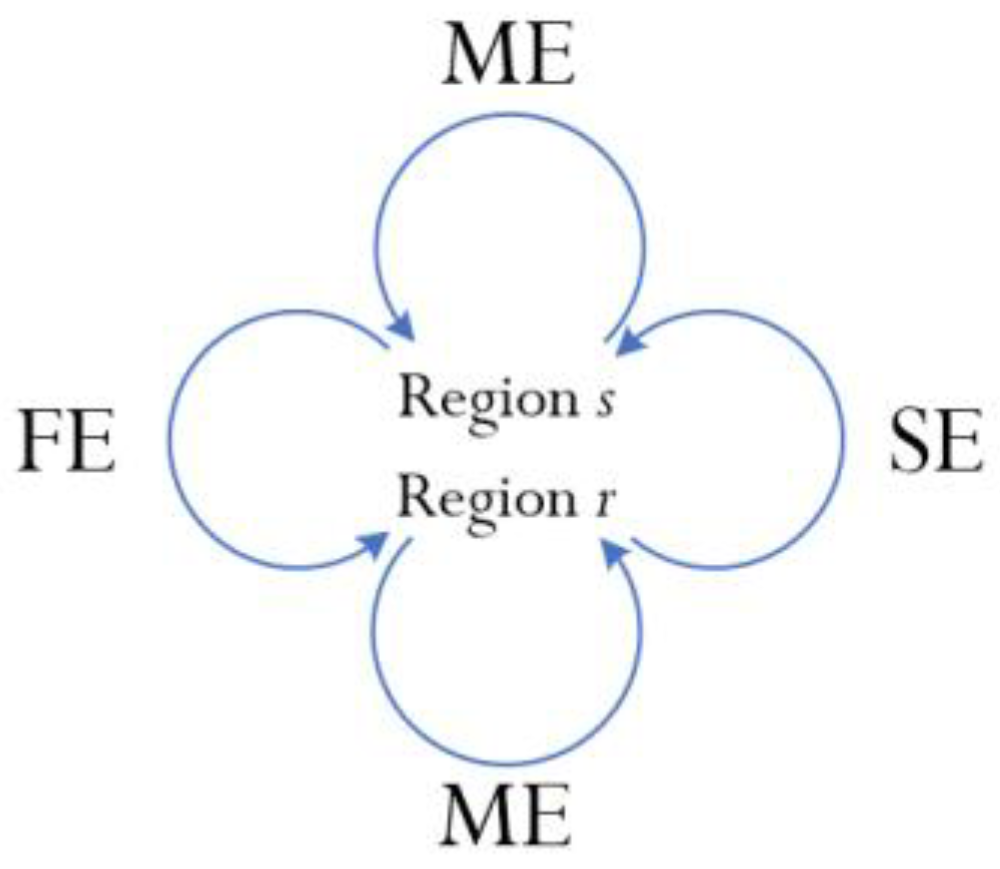
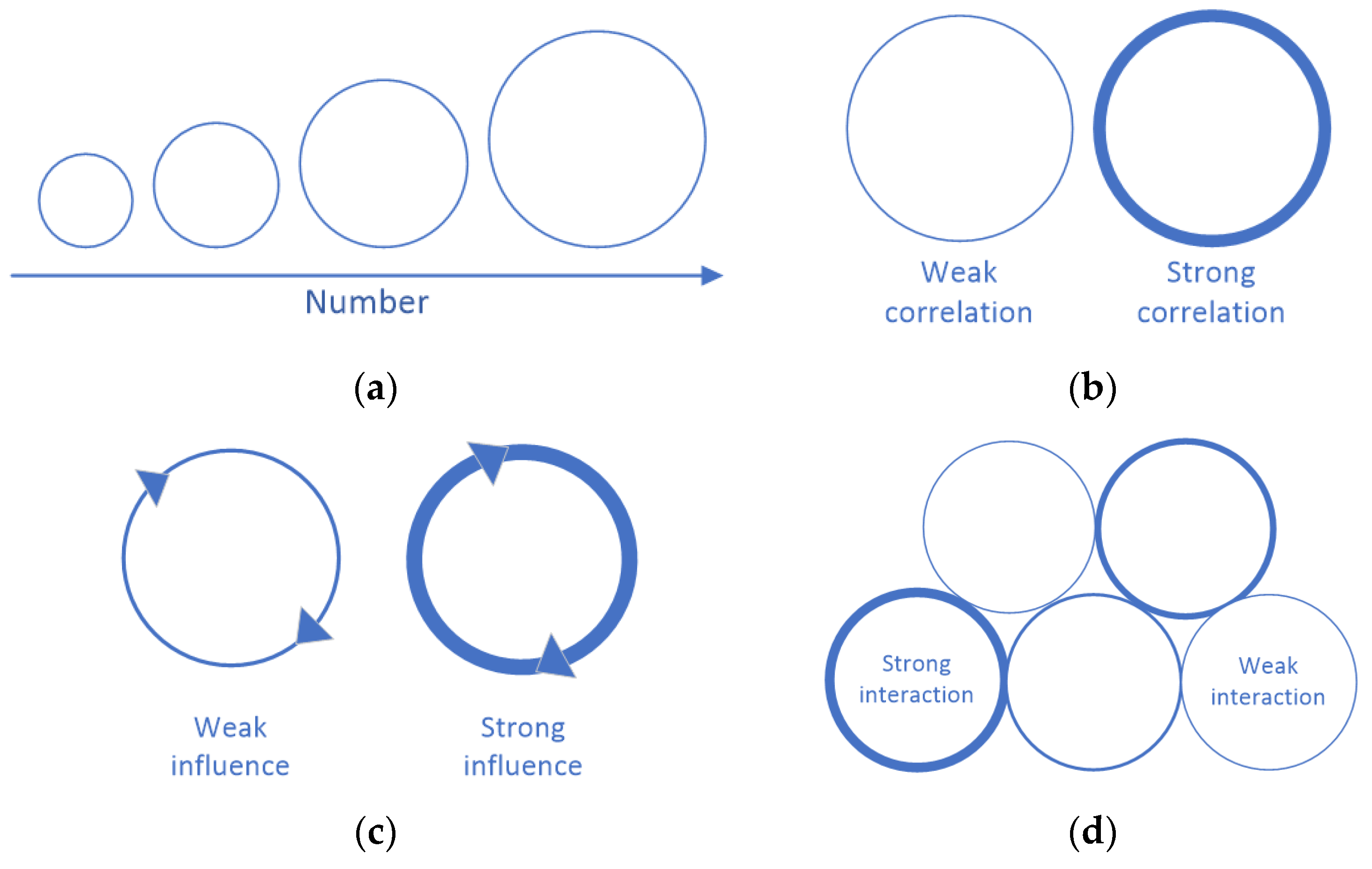
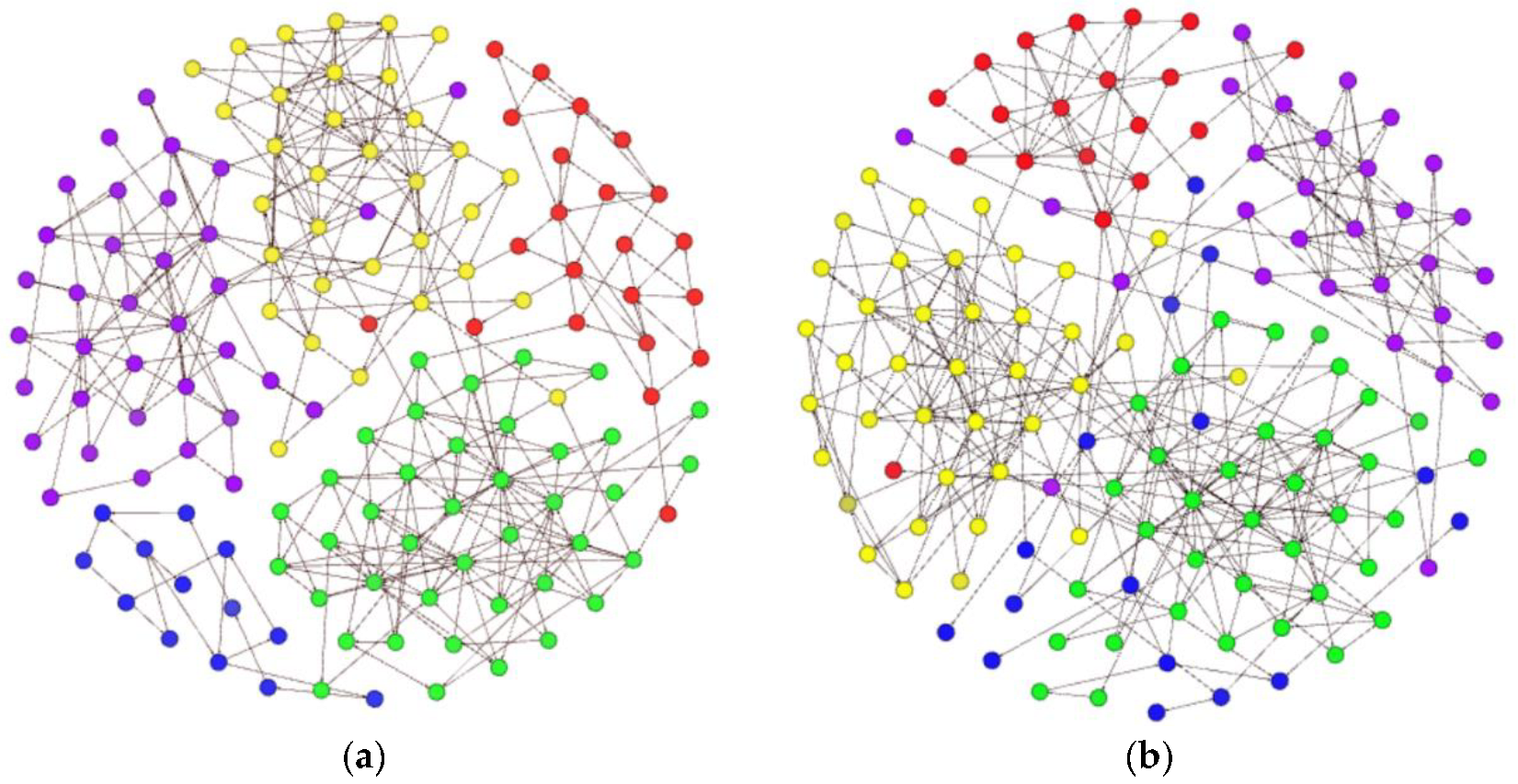

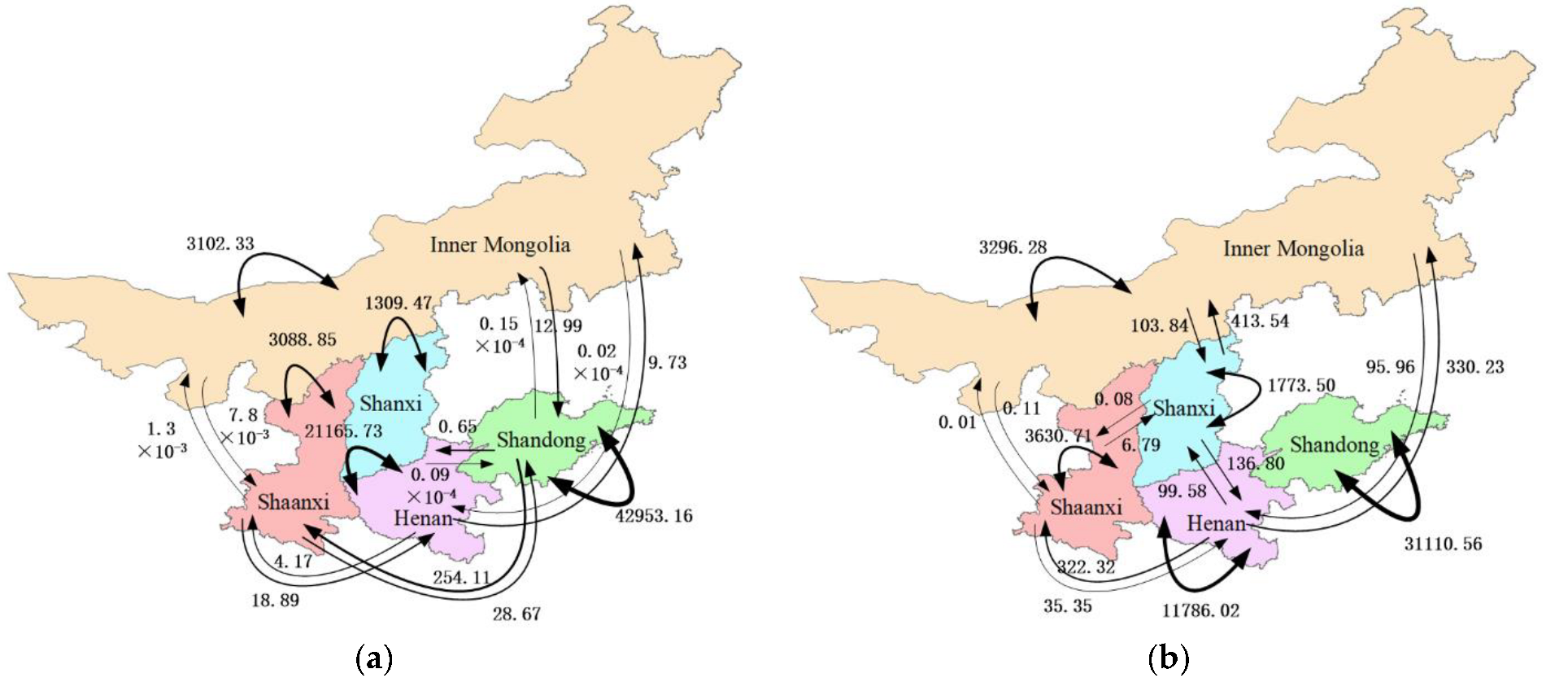
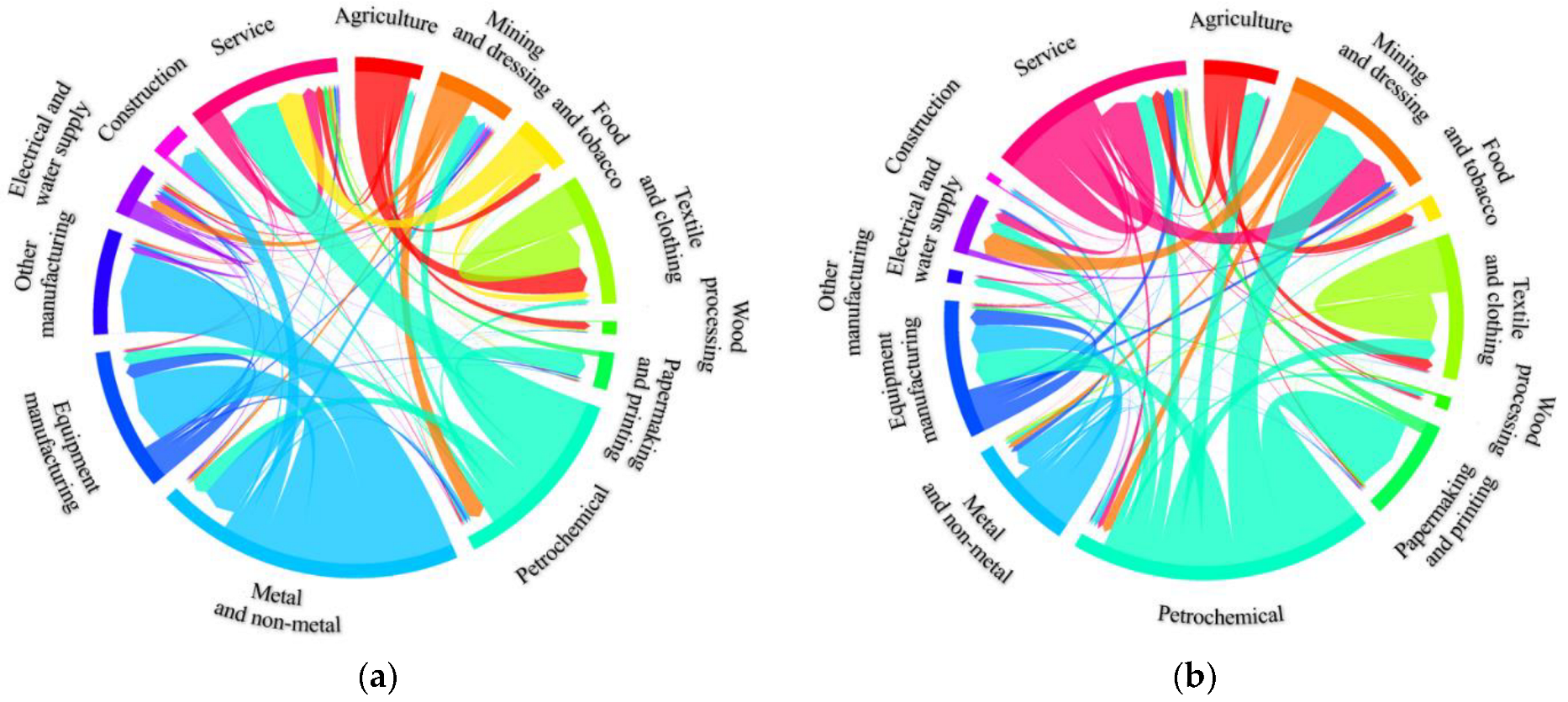
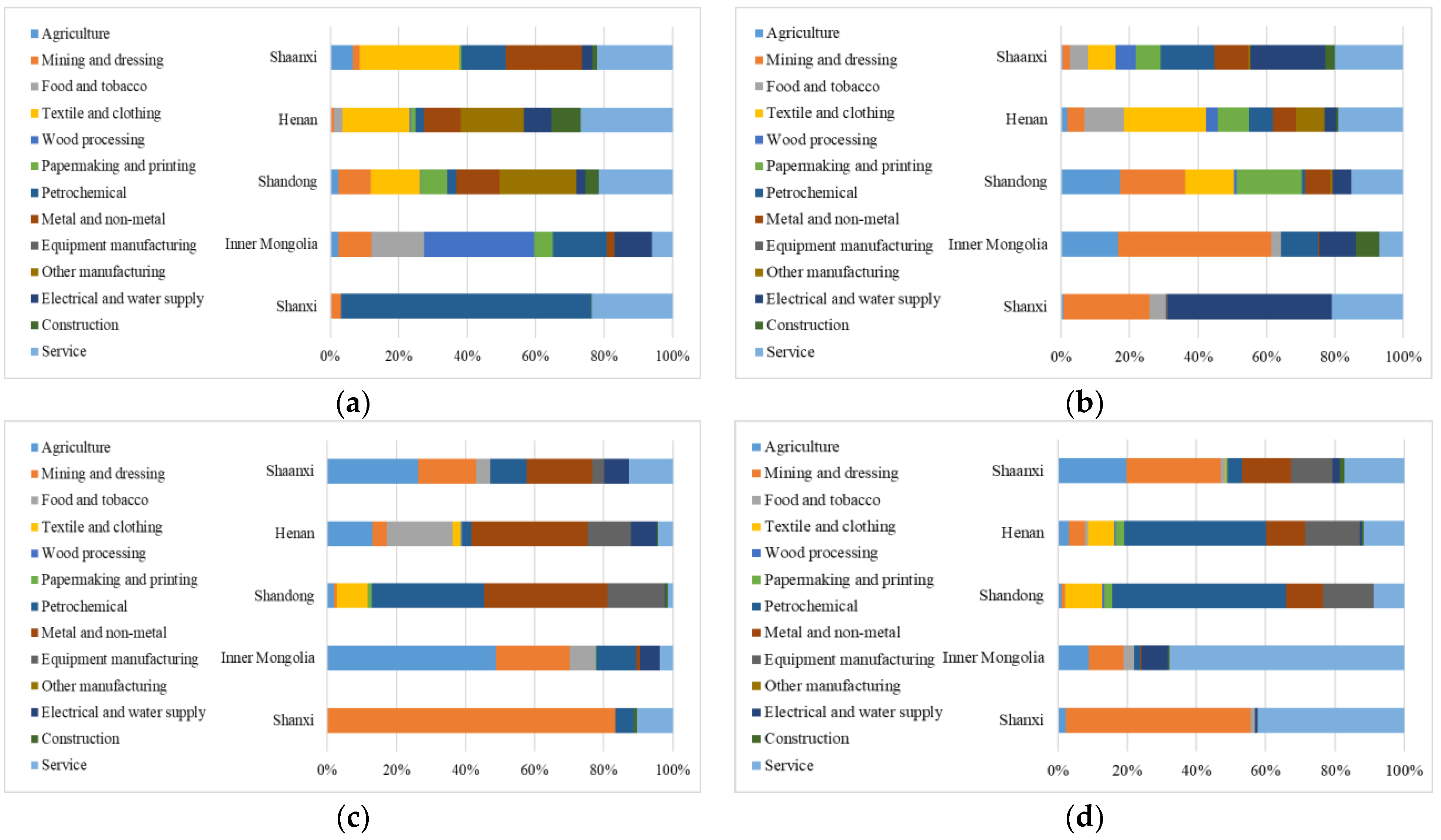
| Region | ME | SE | FE | |||
|---|---|---|---|---|---|---|
| 2012 | 2017 | 2012 | 2017 | 2012 | 2017 | |
| Shanxi | 97.851 | 93.795 | 8.014 | 10.255 | 0.167 | 0.191 |
| Inner Mongolia | 116.532 | 90.240 | 11.367 | 8.068 | 0.410 | 1.252 |
| Shandong | 184.404 | 182.533 | 42.826 | 26.823 | 0.657 | 0.138 |
| Henan | 132.580 | 110.437 | 19.779 | 20.381 | 0.353 | 0.628 |
| Shaanxi | 106.962 | 89.983 | 9.348 | 8.327 | 0.581 | 0.499 |
Publisher’s Note: MDPI stays neutral with regard to jurisdictional claims in published maps and institutional affiliations. |
© 2022 by the authors. Licensee MDPI, Basel, Switzerland. This article is an open access article distributed under the terms and conditions of the Creative Commons Attribution (CC BY) license (https://creativecommons.org/licenses/by/4.0/).
Share and Cite
Yin, C.; Cui, Y.; Liu, Y. Effect and Mechanism of Economic Circulation in the Middle and Lower Reaches of the Yellow River: Multiregional Input–Output Model and Industrial Complex Network Approaches. Sustainability 2022, 14, 12922. https://doi.org/10.3390/su141912922
Yin C, Cui Y, Liu Y. Effect and Mechanism of Economic Circulation in the Middle and Lower Reaches of the Yellow River: Multiregional Input–Output Model and Industrial Complex Network Approaches. Sustainability. 2022; 14(19):12922. https://doi.org/10.3390/su141912922
Chicago/Turabian StyleYin, Chong, Yingxin Cui, and Yue Liu. 2022. "Effect and Mechanism of Economic Circulation in the Middle and Lower Reaches of the Yellow River: Multiregional Input–Output Model and Industrial Complex Network Approaches" Sustainability 14, no. 19: 12922. https://doi.org/10.3390/su141912922
APA StyleYin, C., Cui, Y., & Liu, Y. (2022). Effect and Mechanism of Economic Circulation in the Middle and Lower Reaches of the Yellow River: Multiregional Input–Output Model and Industrial Complex Network Approaches. Sustainability, 14(19), 12922. https://doi.org/10.3390/su141912922






